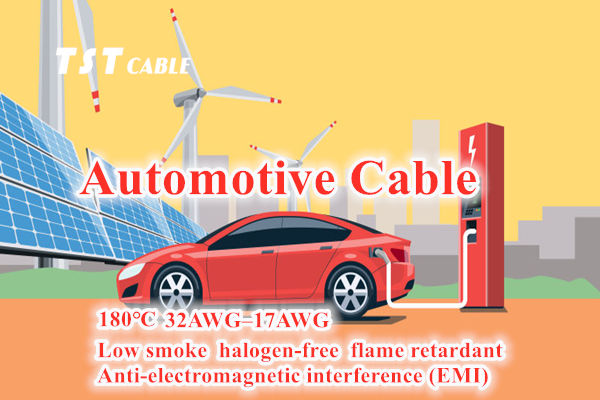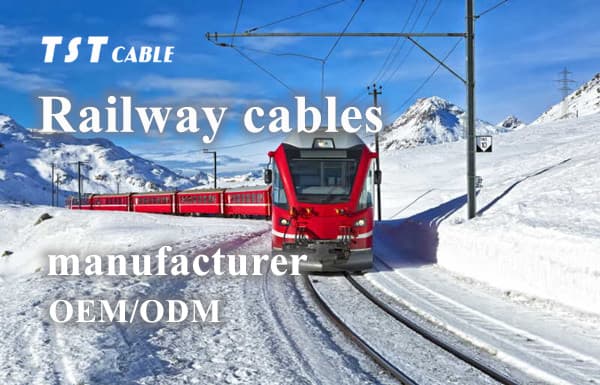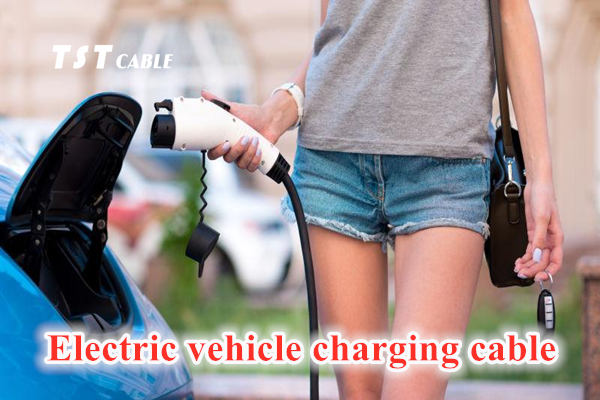Do you know about automotive cable low voltage differential signaling? Do you know how to choose the right LVDS wire? Read the automotive cable LVDS wire application guide in one article.

LVDS (Low Voltage Differential Signaling) automotive cable is a high-speed data transmission cable specially designed for automotive electronic systems. It uses low voltage differential signaling technology to transmit data, with low power consumption, high bandwidth and good anti-interference ability. LVDS technology has been widely used in the automotive industry due to its low power consumption, low bit error rate, low crosstalk and low radiation.
Below, TST CABLES will give you a detailed introduction to the technical characteristics and applications of LVDS automotive cables.
Technical characteristics of LVDS automotive cables
Low voltage signal: LVDS uses a very low voltage swing (about 350mV), which reduces power consumption and reduces electromagnetic interference (EMI).
Differential signal transmission: Data is transmitted through a pair of balanced differential lines. This configuration improves signal integrity and anti-interference ability.
High-speed transmission: LVDS can achieve data transmission rates of up to several thousand Mbps, and even up to 1.923Gbps in some cases.
Low power consumption: LVDS devices are usually manufactured using CMOS technology and have low static power consumption.
Simple connection: LVDS connections usually only require simple resistor matching, which simplifies circuit layout.
Compatible with multiple topologies: LVDS can be used in point-to-point, multi-branch or multi-point topologies.
LVDS car cable construction
LVDS car cables usually contain the following parts:
Conductor: Copper wire used to transmit signals.
Insulation layer: Insulation material surrounding the conductor to protect the conductor and reduce crosstalk.
Shielding layer: Optional metal shielding layer (such as aluminum foil or copper mesh) used to reduce external electromagnetic interference.
Ground wire: Ground wire used in pair with signal wire to form a loop.
Sheath layer: The outermost protective layer that protects the entire cable from mechanical damage.
LVDS car cable application scenarios
LVDS car cables are widely used in various electronic systems inside the car, including but not limited to:
Camera system:
Rearview camera: Used to display the situation behind the vehicle when reversing.
360-degree surround view system: Provides a full range of views through multiple cameras to help drivers better understand the surrounding environment.
Front view camera: used in ADAS systems such as automatic emergency braking system (AEB), lane departure warning system (LDW), etc.
Infotainment system:
In-vehicle display: LVDS technology is used to connect central touch screen, instrument panel display, etc.
Navigation system: LVDS connection can provide high-definition maps and real-time navigation information.
Multimedia player: connection between devices such as DVD player, satellite radio and screen.
Advanced driver assistance system (ADAS):
Night vision system: provides additional vision when driving at night.
Blind spot monitoring system: detects blind spots around the vehicle through the camera.
Pedestrian detection system: uses the camera to detect pedestrians or other obstacles in front.
Vehicle monitoring system:
Sensor data transmission: LVDS cable is used to transmit data from various sensors (such as temperature sensors, pressure sensors, etc.).
LVDS automotive cable advantages
High-speed data transmission: LVDS can maintain high-speed data transmission over a long distance.
Anti-interference ability: The differential signal transmission method makes LVDS effectively resistant to electromagnetic interference inside the car.
Low power consumption: Low voltage swing and constant current drive mode reduce power consumption.
Easy wiring: Simple circuit layout and connection methods facilitate wiring.
Reliability: Low bit error rate and low crosstalk improve the reliability of data transmission.
Challenges and solutions of LVDS automotive cables
Electromagnetic compatibility (EMC): Although LVDS itself has good anti-interference ability, measures still need to be taken to reduce EMC problems in complex automotive environments.
Shielding layer: Adding a shielding layer to the cable can further reduce the impact of EMI.
Filter: Use filters at both ends of the cable to reduce electromagnetic interference.
Cost: The cost of LVDS technology is generally higher than that of traditional analog video transmission technology.
Cost optimization: Reduce costs through improved design and mass production.
Interface standardization: Ensure the consistency of LVDS interfaces between different suppliers.
Follow standards: Strictly comply with relevant LVDS standards, such as those set by VESA (Video Electronics Standards Association).
Adaptability: As automotive electronic systems become more and more complex, LVDS needs to be continuously updated to adapt to new application scenarios and technical requirements.
Technological innovation: Continuous technological research and development, such as increasing data transmission rates and improving signal integrity.
Future Development of LVDS Automotive Cables
With the continuous development of autonomous driving technology and automotive electronics, LVDS automotive cables will continue to play an important role. Future development trends may include:
Higher data rates: With the integration of high-definition video and more sensors, faster data transmission speeds are required.
Lighter materials: In order to reduce the overall vehicle weight, lighter but equally reliable materials may be adopted.
Smart cables: Integrate sensors and diagnostic functions to make the cable itself part of the intelligent system.
Sustainability: Use more environmentally friendly materials and production processes to reduce environmental impact.
Why do LVDS automotive cables use differential signals?
Differential signaling technology can effectively reduce crosstalk and electromagnetic interference (EMI) during signal transmission. Because the signal is transmitted on a balanced pair of wires, any common-mode noise will be offset, thereby improving signal integrity and reliability.
What is the voltage range of LVDS automotive cables?
The operating voltage range of LVDS automotive cables is generally around 350mV. This low voltage swing helps to reduce power consumption and reduce radiation.
What is the maximum data transmission rate of LVDS automotive cables?
LVDS automotive cables can support data transmission rates up to several thousand Mbps, and some high-end applications can even reach 1.923Gbps or higher.
What are the advantages of LVDS automotive cables compared to other types of automotive cables?
The advantages of LVDS automotive cables are their high-speed data transmission capabilities, low power consumption, anti-interference capabilities, and reliability. These characteristics make them particularly suitable for application scenarios that require high-quality video transmission.
What are the main application scenarios of LVDS automotive cables?
LVDS automotive cables are widely used in automotive camera systems (such as rearview cameras, surround view systems), infotainment systems, ADAS systems (advanced driver assistance systems), and vehicle monitoring systems.
How do LVDS automotive cables reduce electromagnetic interference?
In addition to using differential signaling technology, LVDS automotive cables can further reduce electromagnetic interference by adding shielding layers, using suitable connectors, and terminal resistors.
What is the construction of LVDS automotive cables?
LVDS automotive cables usually contain conductors (copper wires), insulation layers, shielding layers (optional), and sheath layers. The conductor is used to transmit signals, while the shielding layer can provide additional protection to reduce interference.
Does LVDS automotive cable require special connectors?
LVDS automotive cables usually require the use of specific connectors to ensure signal integrity. These connectors are usually designed specifically for LVDS signals to ensure proper impedance matching.
What should be paid attention to when maintaining LVDS automotive cables?
When maintaining LVDS automotive cables, you should pay attention to regularly checking the cables for signs of wear or damage, and ensure that the cables are properly grounded to reduce interference.
How do LVDS automotive cables cope with high temperatures in automotive environments?
LVDS automotive cables usually use high-temperature resistant materials to cope with high-temperature environments such as the engine compartment of a car. In addition, the insulation and jacket layers of the cable will also use high-temperature resistant materials.
Are LVDS automotive cables suitable for all automotive electronic systems?
LVDS automotive cables are best suited for application scenarios that require high-speed data transmission. For applications that do not require high-speed transmission, other types of cables may be used.
How do LVDS automotive cables ensure signal integrity?
By using differential signals, appropriate termination resistors, correct wiring techniques, and appropriate cable shielding, reflections and signal attenuation can be minimized to ensure signal integrity.
How much does an LVDS automotive cable cost?
Compared with traditional analog video cables, LVDS automotive cables may cost more, but with technological advancement and mass production, the cost is gradually decreasing.
How do LVDS automotive cables adapt to future automotive technology developments?
As automotive electronic systems become more complex, LVDS technology is also evolving, such as supporting higher data rates, lower power consumption, and better signal quality.
What are the installation precautions for LVDS automotive cables?
When installing LVDS automotive cables, avoid excessive bending or twisting of the cables, keep the cables away from heat sources, and use appropriate clamps to fix the cables.
What is the difference between LVDS automotive cables and HSD (High Speed Data) cables?
HSD cables are also high-speed data transmission cables, but they may use different signaling technologies. LVDS is a specific implementation of HSD that focuses on low-voltage differential signaling.
How long is the service life of LVDS automotive cables?
The service life of LVDS automotive cables depends on their materials, manufacturing quality, and usage environment. Generally speaking, high-quality LVDS automotive cables can remain in good condition throughout the life cycle of the car.
How do LVDS automotive cables integrate with existing automotive electronic systems?
LVDS automotive cables can be integrated with existing automotive electronic systems through dedicated interfaces and controllers. This usually involves the use of dedicated LVDS driver and receiver chips.
What is the future development trend of LVDS automotive cables?
In the future, LVDS automotive cables will develop towards higher data transmission rates, lighter materials, higher reliability and lower costs. In addition, with the advancement of autonomous driving technology, LVDS cables will need to support more sensor data transmission.
LVDS automotive cables are an indispensable part of modern automotive electronic systems. They provide vehicles with high-performance data transmission capabilities, but also face technical challenges. Through continuous innovation and technological advancement, LVDS will continue to play a key role in the automotive industry. TST CABLES’ LVDS (low voltage differential signal) devices have high-performance 5 V, 3.3 V, 2.5 V and 1.8 V characteristics, and their transmission delay is less than 2.0ns, which can meet today’s high-speed I/O interface requirements. The LVDS series of products provide linear drivers, receivers, transceivers, crosspoints, clock/data distribution and repeaters to meet the current high-speed I/O interface transmission needs that support 8-bit, 16-bit, 18-bit and 32-bit functions.
By understanding the above key information about LVDS automotive cables, you can choose and use these cables more confidently. If you encounter any problems during the installation application, it is always a wise choice to seek help from TST CABLES professional cable engineers. If you have other questions about LVDS automotive cables or need more detailed automotive cable customization requirements, please feel free to send an email to our engineers (lixiangchao@testeck.com) for consultation!
Also available in:
English



